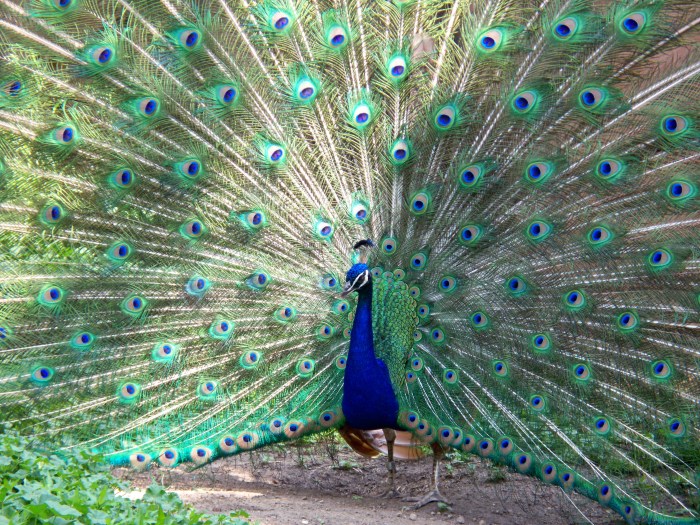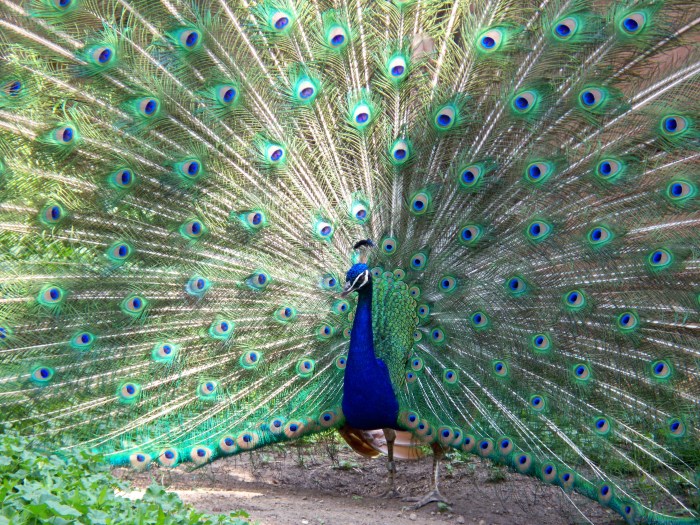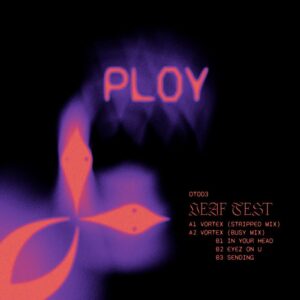Peacock, the majestic bird known for its iridescent plumage and elaborate courtship displays, has captivated human imagination for centuries. From ancient myths to modern art, the peacock has been a symbol of beauty, power, and spiritual significance. This article delves into the fascinating world of peacocks, exploring their biology, behavior, cultural significance, and current conservation status.
Peacocks are native to South Asia and are renowned for their striking appearance. The male peacock, or peafowl, boasts a magnificent tail composed of elongated feathers that can reach up to six feet in length. These feathers are adorned with intricate eye-like patterns, known as ocelli, which are believed to play a crucial role in attracting mates.
The female peacock, or peahen, is less flamboyant, with a more muted brown plumage.
Peacock Anatomy and Biology
The peacock, a majestic bird known for its stunning plumage, is a fascinating creature with unique characteristics. Its anatomy and biology play a crucial role in its survival, courtship displays, and overall life cycle.
Physical Characteristics
The peacock’s physical appearance is striking, with a combination of vibrant colors and intricate patterns. The male peacock, also known as the peafowl, is easily recognizable by its iridescent tail feathers, which are actually elongated upper tail coverts. These feathers are adorned with eye-like markings called ocelli, which are thought to enhance their visual impact during courtship displays.
- Plumage:Peacocks exhibit a striking combination of colors, including iridescent blue, green, and bronze, which are created by the structure of their feathers and the way they reflect light. Their head and neck feathers are a rich, metallic blue, while the body feathers are a deep green.
The most prominent feature, however, is the peacock’s long, trailing tail feathers, which are adorned with vibrant ocelli.
- Size and Weight:Peacocks are relatively large birds, with males typically reaching a length of 3-4 feet and weighing 6-8 pounds. Females, known as peahens, are smaller and less colorful, measuring 2-3 feet in length and weighing 4-5 pounds.
Peacock Tail Feathers
The peacock’s tail feathers are not just for show; they serve a crucial role in courtship displays. The male peacock spreads his tail feathers in a fan-like shape, creating a mesmerizing display of color and pattern. This elaborate display is intended to attract the attention of females and demonstrate his fitness as a potential mate.
- Courtship Displays:The peacock’s tail feathers are essential for attracting mates. During courtship, the male spreads his tail feathers into a magnificent fan, displaying the vibrant ocelli. The larger and more elaborate the display, the more attractive the male is to females.
The ocelli are thought to resemble eyes, which may serve to intimidate rivals or signal the peacock’s strength and health.
- Ocelli:The ocelli on the peacock’s tail feathers are not just decorative; they play a role in attracting mates. These eye-like markings are thought to enhance the visual impact of the peacock’s display, making it more appealing to females. Studies have shown that peahens are more attracted to males with larger and more prominent ocelli.
Diet, Habitat, and Lifespan
Peacocks are omnivorous birds, meaning they consume a variety of food sources. They primarily feed on seeds, fruits, insects, and small reptiles. Their diet varies depending on the availability of food in their habitat.
- Diet:Peacocks are omnivorous, feeding on a diverse range of food sources, including seeds, fruits, insects, small reptiles, and even occasionally small mammals. Their diet is largely influenced by the availability of food in their habitat.
- Habitat:Peacocks are native to the Indian subcontinent and Southeast Asia. They prefer open woodlands, grasslands, and cultivated areas with access to water sources. Their habitat provides them with the necessary food, shelter, and nesting sites.
- Lifespan:In the wild, peacocks can live for up to 15-20 years. However, their lifespan can be shorter in captivity, due to factors such as diet, disease, and stress.
Peacock and Peahen
While the peacock and peahen are both members of the same species, they exhibit distinct physical characteristics. The male peacock is known for its vibrant plumage, while the female peahen is more subdued in appearance.
- Plumage:The most striking difference between the peacock and peahen is their plumage. The male peacock exhibits a stunning display of iridescent colors, while the female peahen is brown and gray, with a smaller and less elaborate tail.
- Size:Peacocks are typically larger than peahens, with males reaching a length of 3-4 feet and females measuring 2-3 feet. This difference in size is attributed to the male’s elaborate tail feathers.
Peacock Behavior and Social Structure
Peacocks, known for their stunning plumage and elaborate courtship displays, exhibit complex social behaviors that are integral to their survival and reproduction. These behaviors are influenced by factors such as mating, territoriality, and communication.
Mating Rituals and Courtship Displays
The peacock’s iconic courtship display is a mesmerizing spectacle. The male peacock, known as a peafowl, will spread his tail feathers into a fan-like structure, displaying the vibrant “eyes” that adorn the feathers. This elaborate display is intended to attract females, known as peahens.
The display is more than just a visual spectacle. The peacock will also use a combination of behaviors, including strutting, bowing, and shaking his feathers, to further impress the peahens. The male peacock’s vocalizations, a series of guttural calls and whistles, also play a role in attracting mates.
The peahens will observe the males’ displays and choose their mate based on the quality and intensity of the display, as well as the male’s overall health and vigor.
The Role of the Peacock’s Call in Communication and Territory Defense
The peacock’s call is a crucial tool for communication. It is used to attract mates, defend territories, and communicate with other peacocks. The call can be described as a series of guttural whistles and croaks. The peacock will use different variations of its call to convey different messages.
For example, a loud, persistent call may be used to defend a territory, while a softer, more melodic call may be used to attract a mate.
Social Hierarchy Within a Peacock Flock
Peacocks live in flocks, with a clear social hierarchy. The dominant male in the flock will typically have access to the most females and the best resources. He will also be responsible for defending the flock’s territory. Lower-ranking males may have limited access to females and resources.
Types of Vocalizations and Their Meanings
Peacocks use a variety of vocalizations to communicate with each other. Here are some examples:
- Courtship Call: A series of guttural whistles and croaks used to attract mates.
- Territory Defense Call: A loud, persistent call used to warn other peacocks away from the territory.
- Alarm Call: A sharp, high-pitched call used to warn the flock of danger.
- Contact Call: A soft, low-pitched call used to communicate with other peacocks in the flock.
Peacock in Culture and Symbolism
The peacock, with its vibrant plumage and captivating display, has captivated human imagination for centuries. Its presence in art, literature, and mythology across diverse cultures speaks volumes about its enduring influence on human thought and symbolism. The peacock’s intricate beauty and striking features have inspired a wide range of interpretations, often reflecting the values and beliefs of different societies.
Peacock in Art and Literature
The peacock’s striking beauty and captivating display have inspired artists and writers throughout history. It has been depicted in various forms of art, from ancient cave paintings to modern sculptures. The peacock’s presence in literature is equally prominent, with its symbolism and imagery enriching stories and poems across cultures.
Examples of Peacock Depiction in Art and Literature
- In ancient Egyptian art, the peacock was associated with the goddess Bastet, the protector of the home and the goddess of cats. The peacock’s tail feathers were often used in decorative motifs and religious ceremonies.
- In Greek mythology, the peacock was associated with Hera, the queen of the gods. According to legend, Hera’s eyes were transformed into the peacock’s iridescent feathers after her husband Zeus betrayed her.
- In Indian art and literature, the peacock is considered a sacred bird and is often depicted in religious paintings, sculptures, and textiles. It is associated with the god Krishna and is often seen as a symbol of beauty, prosperity, and immortality.
- In Chinese culture, the peacock is a symbol of good luck, beauty, and nobility. It is often depicted in traditional paintings and is a popular motif in decorative arts.
- In Western art, the peacock has been a popular subject for centuries. It is often depicted in paintings and sculptures as a symbol of beauty, pride, and immortality.
Symbolic Meanings of the Peacock
The peacock’s symbolism varies across cultures and religions, but some common themes emerge.
Symbolic Meanings in Different Traditions and Religions
- Hinduism: In Hinduism, the peacock is associated with the god Krishna, who is often depicted riding a peacock. The peacock is also a symbol of beauty, prosperity, and immortality. It is believed that the peacock’s eyespots represent the thousand eyes of the god Vishnu, signifying divine protection and vigilance.
- Buddhism: In Buddhism, the peacock represents compassion, wisdom, and enlightenment. It is said to be a symbol of the Buddha’s ability to see all things clearly and with compassion.
- Christianity: In Christianity, the peacock is often associated with the resurrection of Christ. The bird’s ability to shed its feathers and grow new ones is seen as a symbol of renewal and eternal life.
- Greek Mythology: In Greek mythology, the peacock is associated with Hera, the queen of the gods. It is said that Hera’s eyes were transformed into the peacock’s iridescent feathers after her husband Zeus betrayed her. The peacock is also seen as a symbol of royalty, power, and beauty.
- Other Cultures: In many other cultures, the peacock is seen as a symbol of beauty, pride, and immortality. Its iridescent feathers are often used in decorative arts and traditional ceremonies.
Use of Peacock Feathers in Traditional Ceremonies and Rituals
Peacock feathers have been used in traditional ceremonies and rituals across cultures for centuries.
Examples of Peacock Feather Use in Ceremonies and Rituals
- India: In India, peacock feathers are often used in Hindu religious ceremonies and rituals. They are believed to bring good luck and prosperity. Peacock feathers are also used to decorate temples and homes.
- China: In China, peacock feathers are used in traditional weddings and other ceremonies. They are considered to be a symbol of good luck and happiness.
- Native American Cultures: In some Native American cultures, peacock feathers are used in healing ceremonies and rituals. They are believed to have spiritual power and are used to connect with the spirit world.
- Other Cultures: Peacock feathers are used in various traditional ceremonies and rituals around the world. They are often used to decorate objects, clothing, and altars.
Cultural Interpretations of the Peacock
The peacock’s cultural interpretations vary widely, reflecting the diverse beliefs and values of different societies.
Comparing and Contrasting Cultural Interpretations
| Culture | Interpretation |
|---|---|
| India | Sacred bird, symbol of beauty, prosperity, and immortality |
| China | Symbol of good luck, beauty, and nobility |
| Greece | Associated with Hera, queen of the gods, symbol of royalty, power, and beauty |
| Christianity | Symbol of the resurrection of Christ, renewal, and eternal life |
| Native American Cultures | Symbol of spiritual power, used in healing ceremonies and rituals |
Peacock Conservation and Threats

The majestic peacock, with its vibrant plumage and captivating dance, faces a multitude of threats that jeopardize its survival. Understanding these threats and the conservation efforts undertaken to mitigate them is crucial for ensuring the continued existence of this iconic bird.
Habitat Loss and Degradation
Habitat loss is a primary threat to peacock populations worldwide. As human populations expand and land is converted for agriculture, urbanization, and other development activities, peacock habitats are fragmented and degraded. This reduces the availability of suitable nesting sites, food sources, and space for their elaborate courtship displays.
Poaching and Illegal Trade
Peacocks are highly sought after for their beautiful feathers, which are used in traditional ceremonies, decorations, and fashion accessories. This demand fuels illegal poaching and trade, putting pressure on wild populations. The feathers are often collected from the birds, sometimes even resulting in their death.
Climate Change
Climate change poses a significant threat to peacocks, impacting their habitat and food sources. Changes in rainfall patterns, increased temperatures, and extreme weather events can disrupt breeding cycles, reduce food availability, and make peacocks more vulnerable to diseases.
Conservation Efforts
Several conservation efforts are underway to protect peacocks from these threats. These efforts include:
- Habitat Protection and Restoration:Establishing protected areas and restoring degraded habitats are crucial for providing safe havens for peacocks. This involves creating wildlife sanctuaries, national parks, and community-based conservation initiatives.
- Anti-Poaching Measures:Stricter enforcement of anti-poaching laws, public awareness campaigns, and alternative livelihood programs for communities involved in poaching can help curb the illegal trade in peacock feathers.
- Sustainable Use:Promoting sustainable use practices, such as breeding peacocks in captivity for their feathers, can reduce the pressure on wild populations. This requires strict regulations and monitoring to ensure ethical and sustainable practices.
- Research and Monitoring:Ongoing research on peacock ecology, population dynamics, and threats is essential for developing effective conservation strategies. This includes monitoring population trends, identifying key threats, and evaluating the effectiveness of conservation interventions.
Current Status of Peacock Populations
The current status of peacock populations varies significantly across different regions:
| Region | Status | Population Estimate | Major Threats |
|---|---|---|---|
| India | Least Concern | Large and widespread | Habitat loss, poaching, and human-wildlife conflict |
| Sri Lanka | Endangered | Declining | Habitat loss, poaching, and invasive species |
| Southeast Asia | Vulnerable | Declining | Habitat loss, poaching, and deforestation |
| Africa | Least Concern | Stable | Habitat loss and human-wildlife conflict |
Effectiveness of Conservation Strategies
The effectiveness of conservation strategies for protecting peacocks varies depending on the specific threats and the level of implementation. In some areas, habitat protection and anti-poaching measures have been successful in stabilizing or increasing populations. However, in other regions, where threats are more intense or conservation efforts are limited, peacock populations continue to decline.
Peacock in Modern Society
The peacock, with its striking plumage and captivating displays, continues to fascinate and inspire humans in the 21st century. Its presence in zoos, wildlife sanctuaries, and cultural depictions reflects its enduring appeal and significance in modern society.
Peacock in Zoos and Wildlife Sanctuaries
Zoos and wildlife sanctuaries play a crucial role in educating the public about peacocks and their conservation needs. These institutions provide a safe and controlled environment for peacocks, allowing visitors to observe their unique behaviors and learn about their ecological roles.
- Zoos often exhibit peacocks in open enclosures that mimic their natural habitats, showcasing their social interactions and mating rituals.
- Wildlife sanctuaries, dedicated to the conservation of endangered species, provide a refuge for peacocks facing habitat loss and other threats.
- Through educational programs and interactive exhibits, zoos and sanctuaries raise awareness about the importance of peacock conservation and the challenges they face in the wild.
Peacock Feathers in Fashion and Design
Peacock feathers, with their iridescent colors and intricate patterns, have long been prized for their aesthetic beauty and have found a place in various forms of fashion and design.
- Peacock feathers are used in traditional and contemporary fashion, adorning garments, hats, and accessories.
- The feathers’ vibrant hues and natural patterns inspire designers to create unique and eye-catching designs, adding a touch of elegance and sophistication to their creations.
- In interior design, peacock feathers are incorporated into decorative elements, such as lampshades, wall art, and furniture, adding a touch of opulence and exotic flair to living spaces.
Peacock Symbolism in Popular Culture and Media
The peacock’s striking appearance and symbolic connotations have made it a recurring motif in popular culture and media.
- In literature, peacocks are often used as metaphors for beauty, pride, and immortality.
- Films and television shows often feature peacocks as symbolic representations of luxury, grandeur, and exoticism.
- In music, the peacock’s plumage has inspired artists to create works that capture its vibrant colors and majestic presence.
Peacock in Modern Art, Film, and Literature
The peacock’s captivating beauty and symbolic significance have inspired countless artists, filmmakers, and writers throughout history.
- In modern art, peacocks are frequently depicted in paintings, sculptures, and installations, exploring themes of beauty, nature, and spirituality.
- Films, such as “The Jungle Book” (1967) and “The Birdcage” (1996), feature peacocks as symbolic characters, representing themes of pride, individuality, and self-expression.
- In literature, peacocks appear in works by renowned authors, including Oscar Wilde’s “The Picture of Dorian Gray” and Salman Rushdie’s “Midnight’s Children,” where they symbolize themes of vanity, transformation, and cultural identity.
Final Review
From their captivating courtship rituals to their enduring cultural symbolism, peacocks remain a source of wonder and fascination. As we continue to learn more about these magnificent birds, it is essential to ensure their survival in the face of increasing threats to their habitat and populations.
By understanding and appreciating the importance of peacocks, we can play a vital role in protecting these beautiful creatures for generations to come.





